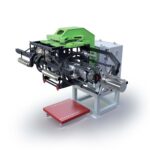The carbon fiber composite materials from the automotive company of Sant’Agata Bolognese boarded the International Space Station and took off for outer space last November: Automobili Lamborghini sent components developed and produced in-house to the ISS for scientific purposes.
Automobili Lamborghini has been collaborating with the Houston Methodist Research Institute since beginning of 2018, combining the high level competence of Methodist in medical research, Lamborghini’s Advanced Composites excellence and the common interest of testing the composite materials to evaluate their biocompatibility.
The tests aim at analyzing the response of five different composite materials produced by Lamborghini to the extreme stresses induced by the space environment, in view of future applications on its super sports cars and in the medical field. This testing campaign is sponsored by the ISS U.S. National Laboratory and is overseen by the Houston Methodist Research Institute.
Automobili Lamborghini has full know-how of the entire “composite chain” from concept to development, from production to repair, through the management of the most advanced design techniques, simulation, use of materials, and the adoption of numerous production processes to ensure the use of the “right technology in the right place”.
This process entails massive use of various types of composite materials and, due to its nature, leads to the creation of material scraps mainly from the production process of the Aventador monocoque, the quantities for which are currently about 24 tons a year. For three years, Automobili Lamborghini has been working on a project with the goal of making this process more sustainable by studying and implementing the best carbon recycling process aimed at recovering the recyclable material and processing it to be reapplied on new products.
Since November 2019 the material is divided by fiber type and collected in specific bags to be sent to the partner who applies the pyrolysis process to dissolve the resin and recover the fibers. The fibers are then processed to make a “non-woven fabric”, thus creating a new base product for new applications. Lamborghini is studying a number of solutions for reapplying this product, which can be impregnated again with various thermoplastic and thermosetting resins and processed using various technologies. Some applications being studied are car floors, brackets and supports, and proto molds. This carbon recycling process guarantees a closed cycle in which the fiber is not only recovered but also reapplied on our products.
Source: Lamborghini












